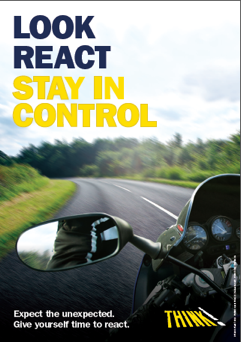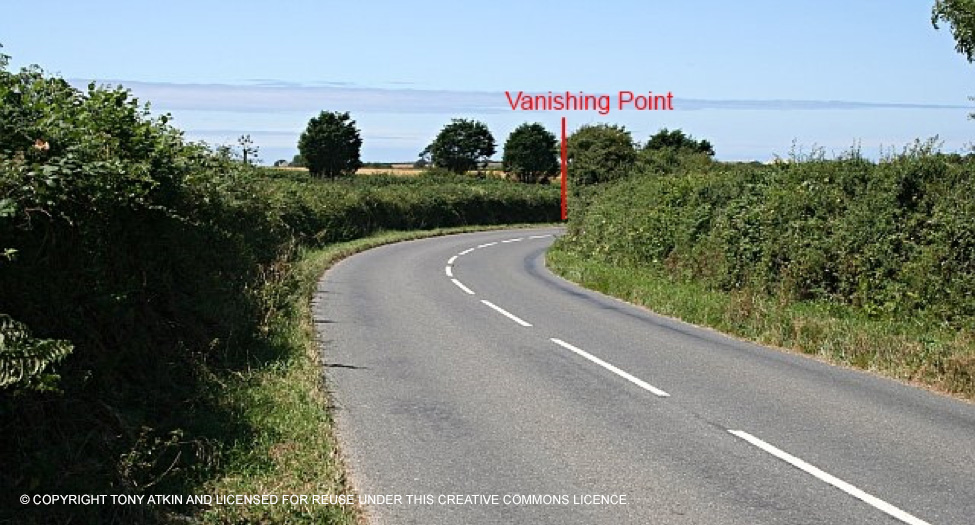 Constantly search the road ahead for changing conditions. Scan the road near and far.
Constantly search the road ahead for changing conditions. Scan the road near and far.- Become an expert at spotting hazards such as mud on the road, loose chippings, inspection covers, pot holes, worn and shiny tarmac, painted surfaces, diesel spills, animals etc.
- Ride according to the road conditions and within your own abilities.
- Pay attention to road markings and signage which will warn you of changes in the road ahead.
- Plan ahead when approaching junctions.
- Always signal before making a manoeuvre.
- When riding in groups, ride to the bike behind. Keep the rider behind you in your mirrors – slow down when you haven’t seen the bike behind for a while. When they are visible, away you go again.
- THINK – motorcyling
Reading the Road
A useful way to help judge your approach speed and speed through corners is to use the ‘Vanishing Point’ . This is where, as you look into the corner, the two sides of the road (or verges) appear to meet. If you keep looking towards this point you’re looking far enough ahead to ride smoothly and see problems early. But if you also notice whether this point is moving towards you or away, you have a crucial indication of what the corner is doing next.
If the vanishing point is moving towards you, then the bend is tightening up and you need to roll off the throttle.
If it’s moving away from you, the bend is opening out. BUT… Remember that the ‘vanishing point’ tells you nothing about the potential hazards beyond what you can see.
If you read the hedges rather then the kerbs or if the verge changes width or doesn’t follow the line of the road, it can lead to you thinking the bend is more open than it is. Corners where the road changes elevation are difficult to read – they can appear more open than they actually are, causing you to run in too fast.
 Ease off the throttle smoothly and get in the right gear early. Aim for a neutral throttle opening through the bend.
Ease off the throttle smoothly and get in the right gear early. Aim for a neutral throttle opening through the bend.
Wait until you see the exit of the bend and can see where the road goes before applying the power.
We all counter-steer without thinking about it, but some positive forward pressure on the inside bar will force the bike to turn quicker, which may make the difference between running wide into a wall or oncoming vehicle or getting home safely.
If you lack confidence in cornering, you may turn in early to avoid having to turn hard later on. Turning in early may cause you to run wide and veer into the roadside or oncoming traffic. Wait until you can see the exit of the corner before you turn in tighter. Find a speed that doesn’t cause panic and practice turning in later.
On a straight road with no other traffic present, practice braking with bent arms.
In a stressful situation, it is natural to brace yourself for an impact but with bent arms you will have better control, find it easier to change direction and have more feel for the front tyre. Grip the tank with your thighs and try to move your elbows around. If you can’t, you are hanging on too tight.
On a straight road with no other traffic, practice braking hard at different speeds.
Start slow and build up as you get used to braking hard. This will not only give you confidence when you have to do it for real but will reduce your stopping distance in an emergency.
Don’t be pressurised by your mates, or the rider following you, to rush into a corner faster than you are comfortable with.

